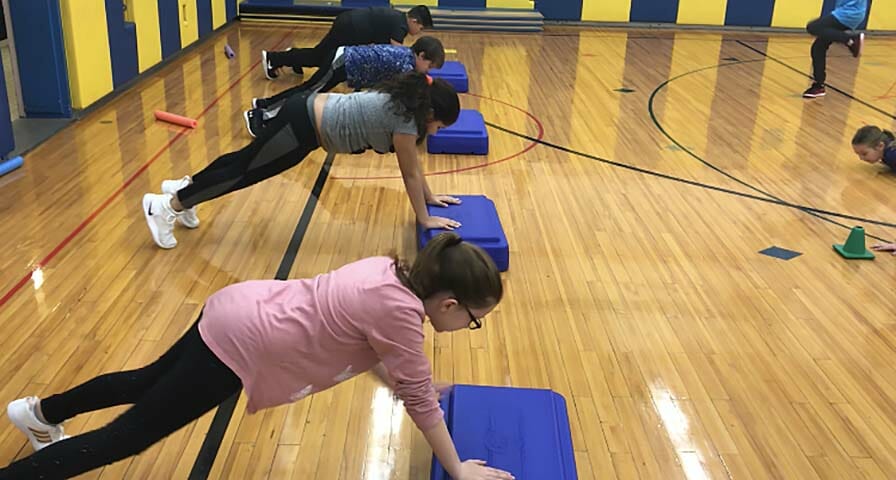Focus on Fitness Skills Personalizes PE, Use of Heart Rate Monitors Motivates Students to Find Success
By introducing more lessons around fitness, in particular HIIT lessons in PE, teachers see students more engaged in each workout and working hard to reach daily goals.
Today’s PE environment marries heart rate technology with the latest exercise trends. Teachers are creating active programs that use high-intensity interval training (HIIT) to maximize the time students have to exercise. Instead of relying on games or sport-specific skills, more and more teachers build their curriculum around circuit training.
Students wear heart rate monitors such as the IHT ZONE while they complete their circuit. Each student gets several opportunities to review their heart rate data through email and the return screen on the teacher’s computer. Those review opportunities allow students to reflect on what the data shows them:
- Graph of their heart rate throughout the workout
- Time spent exercising in target heart rate zones
- Goal for minutes spent exercising and whether they met the goal
Using their individual data, students of all ages can work on specific training skills that will help them live confident, healthy lifestyles as they become adults. Here are some of the top reasons teachers have transitioned to HIIT Lessons in PE.
Every Student ‘Achieves Greatness’ through HIIT Lessons in PE
“I knew I needed to get these kids more active than they actually were,” said Hampstead (NH) Middle School health and PE teacher Kate Muskrat. “This seems to be what works the best with what we’re trying to get out of the kids. This tailors to an individual’s needs instead of some of the other things we’ve tried.”
Each Friday, Muskrat’s health students head to the gym for a 10-station circuit they call “Fitness Friday.” They spent a minute at each station with a short break between.
The individual workout element drew Muskrat to the circuit. In creating a lesson that encourages each student to simply do their best to complete a circuit, she allowed each student the chance to see success.
“This just seems like something that allows everyone to achieve greatness,” she said.
Using PE Heart Rate Monitors Increases Student Motivation
“We use the ZONE monitors and it has been an unbelievable motivational thing for them. It pushed them,” said Lunenburg (Mass.) High School PE teacher Steve Boone. “They check out their results after class.”
Boone’s students regularly take part in a “Fit For Life Tabata.” The 8-station circuit requires students to exercise for 20 seconds before taking a 10-second break while rotating to the next station. They complete the circuit as many as eight times in a class period, making sure to keep their heart rates in the target zone: vigorous.
“You can see them push themselves to get to their target zone,” Boone said. “[Wearing the ZONE] is a great motivator and this is a great workout they can do to push themselves that way.”
Emphasizing Goal-Setting as an Exercise Necessity
By introducing students to their data through the Spirit System software, teachers reinforce the importance of goal-setting for each workout. In their HIIT lessons for PE, students strive to reach a goal focused on time spent exercising in the target heart rate zones, and they’ve responded.
“Being able to set goals for the kids is a great perk,” said Hamburg (Penn.) Area High School teacher Donine Kelly, who focuses solely on fitness in her PE classes. “Students are much more motivated and tuned into their performance levels for the day. Getting immediate feedback at the end of the period is also a huge plus. They can’t wait to see if they met their goal for the day.”
Teachers want students to keep a goal in mind as they develop a workout plan long after they leave school. Understanding heart rate and how it impacts their overall health and fitness will help them create effective, health-enhancing workouts on their own.
“Lifetime fitness is the foundation that they need to strive for,” said Fort Lupton (Colo.) Middle School health and PE teacher Lindsay Yost. “The kids having this technology so young is very exciting. They’ll be able to take that knowledge and use it as an adult. Whether they are trying to run a 5K or cycling or doing triathlons or playing a pickup basketball game, whatever it may be, as an adult, having the knowledge and the desire to know how a heart rate monitor works will be a huge skill set that they can carry on with them.”
Seeking IHT Spirit System information?


